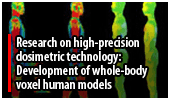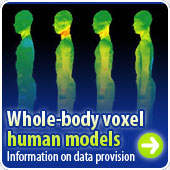Key words for understanding biomedical EMC
- Base station
- A device that intercommunicates with mobile phones, corresponding to the terminal end of a mobile phone network. Generally speaking, it refers to buildings and construction products, including antennas and devices that are used for making direct communication with wireless-communication terminals such as mobile phones and PHS.
- Base station simulator
- A device that creates the same signal as a base station, for use in testing mobile phones, etc.
- Basic restrictions
- These refer to restrictions on the electric, magnetic and electromagnetic field exposures, determined using established health effects as the direct grounds. The physical volumes that are used for these restrictions include current density, Specific Absorption Rate (SAR), and power density. These vary depending on frequency.
- Calibration
- To adjust the read of a measuring instrument by comparing with the standard value.
- Circular polarized wave
- A radio wave whose electric field orientation forms a circle while moving within a plane orthogonal to the direction of propagation. It consists of a horizontally-polarized wave and a vertically-polarized wave, combined at a phase difference of 90 degrees.
- Committee to Promote Research on the Possible Biological Effects of Electromagnetic Fields, the Ministry of Internal Affairs and Communications
- The committee has been issuing proposals on research items pertaining to the safety of radio waves, and on reexamining the radio frequency radiation protection guidelines. It is comprised of medical and biological specialists as well as engineering specialists. In 2007, the Committee compiled a report on the safety of radio waves, based on surveys and research it had carried out over ten years, as well as studies conducted by various other countries, before concluding its activities.
- Compliance test
- To evaluate whether an item or product complies with a certain standard.
- Control group
- A group enrolled in epidemiological studies and human studies whose members do not suffer the disease being studied. The term may also refer to a group whose members are not exposed to factors (radio waves in this case) which are the focus of animal and cell experiments.
- Dosimetry, or exposure evaluation
- When the human body is exposed to radio waves, dosimetry identifies, via measurements and calculations, where in the human body and to what extent the radio waves have been absorbed. In English, the word "dosimetry" is used because the dose, or the amount of exposure, is measured.
- Epidemiological study
- Research carried out to identify the relationship between a disease and the causes of onset of a health-related event by sorting and analyzing patient data collected within a specific region or group.
- Exposure system
- A system that includes antennas and other devices used for irradiating the living body with radio waves, employed in medical and biological experiments conducted to evaluate the biological safety of radio waves.
- ICNIRP
- Acronym for the International Commission on Non-Ionizing Radiation Protection, it draws up and revises international guidelines on exposures to electromagnetic fields, which are officially approved by the WHO.
- Induced ankle current
- This refers to the current which flows through an ankle to ground when a human body is exposed to electromagnetic field.
- International Agency for Research on Cancer (IARC)
- The IARC is a WHO external organization, established as an institution to study the mechanism, epidemiology, and prevention, etc., of carcinogenesis. It evaluates the carcinogenic risks of a variety of chemical substances, radiation and viruses, and publishes their findings as monographs. It is headquartered in Lyon, France. As part of the WHOfs International EMF Project, the IARC carried out an international research project that explored the relationship between mobile phone use and head/neck tumors. The findings are currently being evaluated. The official name is the International Agency for Research on Cancer.
- Medical supervision
- This pertains to the work of having medical specialists confirm the position of the human body tissues and organs that were identified based on the human body's MRI data, as well as any errors in the tissue classification, etc.
- Method of Moments
- A numerical computational method used to analyze electromagnetic fields. It uses Maxwell's equation to derive integral equations for a target structure, and applies weighting functions (moments) to numerically calculate the distribution of currents over a structure. Unlike the FDTD method that can use structures of any given shape, the method of moments allows only certain shapes to be used. The process is also more complicated than the FDTD method. If a certain shape is used, however, this method allows high-precision analysis, so it is often used in antenna calculations.
- MRI
- MRI is a method of creating images of formative information inside a living body using the nuclear magnetic resonance phenomenon, in which an atomic nucleus exposed to a strong magnetic field resonates with radio waves of a specific frequency and then emits radio waves. Since it uses no radiation, unlike X-rays or CT scans, MRI characteristically causes no radiation exposure, and is non-invasive to the human body.
- NICT
- Acronym for the National Institute of Information and Communications Technology. The institute is engaged in research on the safety of radio waves.
- Phantom
- This is an alternative model or material that has the same physical properties as those of the human body.
- Plane wave
- At infinite distance from its source, electric field, magnetic field, and propagation of the electromagnetic wave are directed orthogonally to each others. These electromagnetic waves are called plane waves.
- Radio anechoic chamber
- A laboratory sealed against radio waves from outside and which also prevents their escape. This is done by coating a radio wave-absorbent material on the walls that absorbs electromagnetic waves.
- Radio frequency radiation protection guidelines
- These refer to guidelines on the intensity of radio waves that do not have adverse health effects on the human body, devised in June 1990 by the Ministry of Internal Affairs and Communications. (Partial-body absorption guidelines were added in April 1997.)
- Reference level
- A reference level was set up for conducting actual dosimetry to decide whether an exposure volume exceeds the basic restrictions or not. Staying within the reference level is believed to guarantee conformity with the relevant basic restrictions. However, if an exposure level exceeds the reference level, it does not necessarily mean that it has exceeded the basic restrictions, so more detailed analysis is deemed necessary to evaluate whether the basic restrictions are being complied with.
- RF-ID
- Radiofrequency Identification, or RF-ID, is a mechanism for identifying and tracking humans and objects, using minute wireless chips. Data are stored in highly environmentally-resistant tags, about several centimeters in size, and communication is exchanged with transponders using radio and other electromagnetic waves.
- Risk of developing diseases
- Indicates the degree of risk of developing a certain disease, etc.
- (SAR) probe
- A sensor that is used to measure a certain value (in this case, SAR). It is placed in contact with the part to be measured.
- SAR (Specific Absorption Rate)
- Specific Absorption Rate, or SAR, indicates the amount of power absorbed per unit mass of a biological body when it is exposed to an electromagnetic field.
- standardization
- The process of determining a standard and unifying the specifications and types of products, etc.
- Supercomputer
- An ultra-high performance computer used in large-scale science and technology calculations.
- The finite-difference time-domain (FDTD) method
- A method of creating a Finite Difference using Maxwell's differential equation, which describes the propagation of electromagnetic waves, and solving it in a Time Domain. It can analyze basically anything, as long as the analysis target can be subjected to mesh division.
- UHF band
- The Ultra-High Frequency, or UHF, band, refers to radio waves with a frequency of between 300 MHz to 3 GHz. Mobile phones, PHS, wireless LANs (2.4 GHz band), terrestrial analog and digital TV broadcasts employ UHF-band radio waves.
- Uncertainty
- A parameter that characterizes the deviation of values (associated with measurement results) that may logically be linked to the measurement value. It is expressed as a combination of statistical volume.
- Vertically polarized waves
- These are radio waves with an electrical field that is vertical to the ground.
- VHF band
- The Very High Frequency, or VHF, band, refers to radio waves with a frequency range of 30 MHz to 300 MHz. FM radio broadcasts, analog TV broadcasts, and amateur radio transmissions (50 MHz and 144 MHz) employ VHF-band radio waves.
- Voxel
- While pixels are 'squares' used to build 2-dimensional digital images, voxels are 'cubes' used to build 3-dimensional digital images. Because voxels are expressed as particles with thickness, they can depict cross-sections of 3-dimensional images. Medical image data are represented in voxels.
- Waveguide tube
- A metal tube used for transmitting electromagnetic waves. The wavelength transmitted is determined by the tube's cross-sectional dimensions.
- Wavelength
- In a periodic wave, a wavelength refers to a distance between two same-phase points that continue in the direction of propagation, and is the distance traveled when a wave has oscillated once.
- W-CDMA
- W-CDMA is the acronym for Wideband Code Division Multiple Access, a communication method that complies with the IMT-2000 standard (the third-generation mobile phone method) specified by the International Telecommunication Union. The following data transmission capabilities have been established: 144 kbps while moving at high speed, 384 kbps while walking, and 2 Mbps while stopping. It is a globally unified standard.
- Whole-body resonance
- Human body, as a whole, exhibits a frequency-dependent rate of absorbing electromagnetic energy. The maximum absorption of the electromagnetic field occurs at the whole-body resonance, i.e. when the height of a human body is comparable with a radio wave's wavelength, in which the human body behaves almost like an antenna and absorbs an even greater amount of radio waves. Depending on height and surrounding conditions, whole-body resonance is known to occur within the frequency range of 30 MHz to 300 MHz.
- World Health Organization (WHO)
- The WHO, a specialized institution of the UN, regards health as a basic human right, and was established with the goal of attaining it. It is headquartered in Geneva, Switzerland. The official name is the World Health Organization. Click here for the website on the WHOfs International EMF Project.






